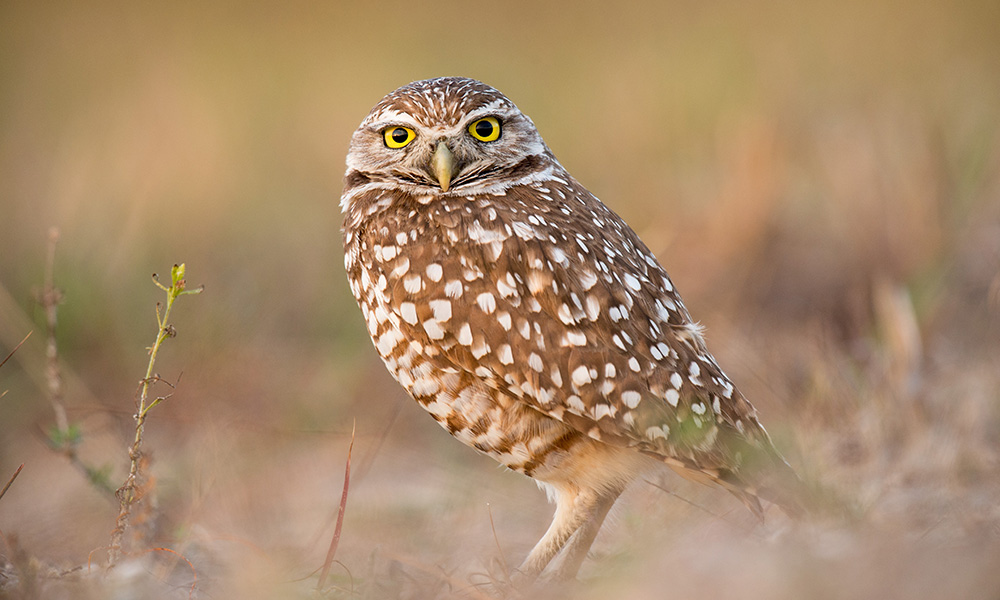
Recent UBCO research explored burrowing owls in the Okanagan and how they’re adapting to climate change. Photo by Ray Hennessy on Unsplash.
As the world grapples with the pressing challenges of climate change, new research from UBC Okanagan emphasizes the critical role of grasslands in sustaining biodiversity, particularly for migrating species like the burrowing owl.
A recent study from Dr. Lilian P. Sales, a postdoctoral fellow working with Dr. Lael Parrott in UBCO’s Earth, Environmental and Geographic Sciences department, explored the burrowing owl and how it’s adapting to climate change. The iconic species might see its habitat expand toward northern latitudes due to changing climates; however, this expansion is contingent on the availability of its primary habitat, native grasslands.
“A key motivation for this is the preservation of the Okanagan grasslands,” says Dr. Sales. “Despite its low abundance, the burrowing owl is often used as a symbol for grassland preservation and serves as a cultural icon linking the land, its people and conservation efforts.”
The burrowing owl depends on grassland environments for nesting and breeding. The study, employing ecological niche models coupled with climate and soil data, projected that under specific high-emission climate change scenarios, the burrowing owl could expand its range three to 10-fold toward northern regions. However, nearly half of these newly suitable environments might lack grassland coverage, predominantly due to human activities like agriculture and urbanization.
This deficiency might hinder the establishment of breeding populations for the owl. Such discoveries underline the urgent need to prioritize the conservation of grasslands across western North America.
“Not only could these grasslands offer sanctuary to the burrowing owl, but they could also serve as pivotal habitats for many other species migrating from the south,” says Dr. Sales.
The researchers strongly advise that any land-use plans for the future should integrate strategies for protecting grassland habitats, which are well adapted to the conditions of our changing climate. Such foresight will ensure that these areas can be practical tools for regional climate adaptation and biodiversity preservation.
“In the Okanagan, conservation areas such as the South Okanagan Grasslands Protected Area and the proposed South Okanagan Similkameen National Park Reserve are critical parts of a strategy for ensuring our landscape can be resilient to climate change,” says Dr. Parrott. “As a climate adaptation strategy, local governments should strive to protect a connected network of grasslands and open habitats from Osoyoos to Vernon.”
A focused approach towards safeguarding grasslands, intertwined with targeted conservation initiatives for species like the burrowing owl and burrow-digging mammals, can potentially maintain the diversity of these unique ecosystems in our changing climate.
“While it’s tempting to label the burrowing owl as a climate change indicator, we lack sufficient data to do so confidently,” Dr. Sales says. “However, we can predict range expansions for grassland-dependent species, and they will need natural cover to thrive.”
Dr. Sales says she was especially invested in the research because it connected her with the Burrowing Owl Conservation Society of BC. The group was instrumental in helping the UBCO researchers give their work real-world context.
The research offers a broader perspective on biodiversity conservation, says Dr. Sales. Landscape management should evolve as species move and adjust their geographic ranges in response to changing climates. Holding onto historical species lists as benchmarks for ecosystem health might become obsolete given the rapid ecological changes expected this century, she says.
“Adopting a forward-thinking approach to conservation might be the key to safeguarding global biodiversity in an ever-changing world,” says Dr. Sales.
The study appears in the journal Science of the Total Environment.